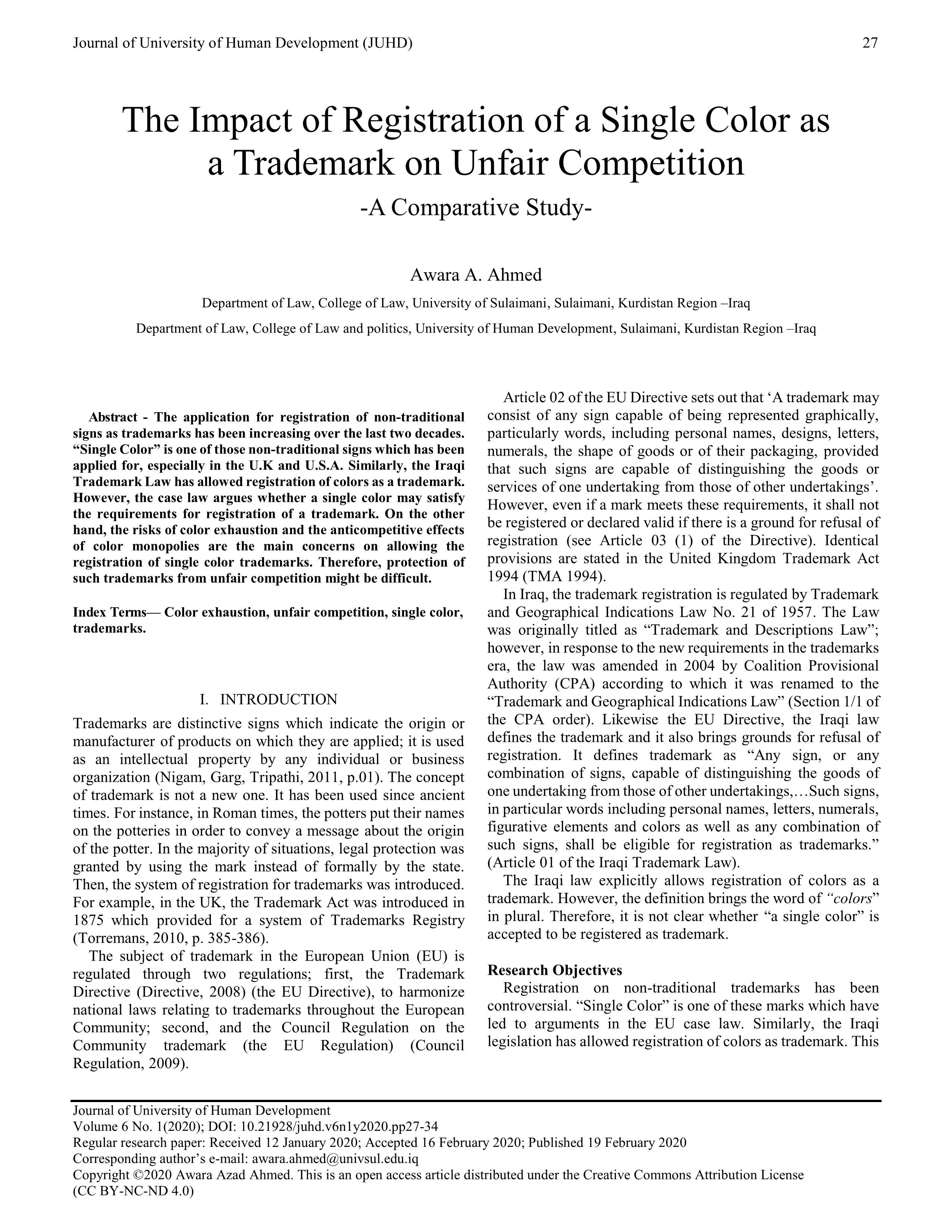The Impact of Registration of a Single Color as a Trademark on Unfair Competition
A Comparative Study
DOI:
https://doi.org/10.21928/juhd.v6n1y2020.pp27-34Keywords:
Color exhaustion, unfair competition, single color, trademarksAbstract
The application for registration of non-traditional signs as trademarks has been increasing over the last two decades. “Single Color” is one of those non-traditional signs which has been applied for, especially in the U.K and U.S.A. Similarly, the Iraqi Trademark Law has allowed registration of colors as a trademark. However, the case law argues whether a single color may satisfy the requirements for registration of a trademark. On the other hand, the risks of color exhaustion and the anticompetitive effects of color monopolies are the main concerns on allowing the registration of single color trademarks. Therefore, protection of such trademarks from unfair competition might be difficult.
References
The Agreement on Trade Related Aspects of Intellectual Property Rights (TRIPS) 1995.
The UK Trademarks Act 1994.
The Iraqi Trademark and Geographical Indications Law No. 21 of 1957 (as Amended in 2004).
The Iraqi Competition and Monopoly Prevention Law No. 14 of 2010.
The Iraqi Consumer Protection Law No. 1 of 2010.
The Iraqi Trade Law No. 149 of 1970 (revoked).
The Iraqi Trade Law No. 30 of 1984.
Directive (2008/95/EC). The Laws of the Member States Relating To Trademarks. L 299/25.
Council Regulation (EC) No. 207/2009 on the Community Trademark. L78/1.
Treaty on the Functioning of the European Union. (1957). Part Three: Union Policies and Internal Actions - Title Vii: Common Rules on Competition, Taxation and Approximation of Laws.
Cases:
Koninklijke Philips Electronics NV v. Remington Consumer Products Ltd. (2002). Case 299/99. ECR I – 5475.
Libertel Groep BV v. Benelux-Merenbureau. (2003). Case C-104/01. ECR I-3793.
Ralf Sieckmann v. Deutsches Patent- und Markenamt (‘Methylcinnamat’). (2002). Case C-273/00. ECR I-11737.
Sat.1 SatellitenFernsehen GmbH v. Office for Harmonization in the Internal Market. (2004). Case C-329/02 P.
Canon Kabushiki Kaisha v Metro-Goldwyn-Mayer Inc. (1998). Case C-39/97. ECR I-05507.
Decision of the Third Board of Appeal. (18 December 2000). Case R 122/1998-3.
Orange Personal Communication Service Ltd, Third Board of Appeal OHIM (February 12, 1998). Case R 7/97-3. ETMR 337.
Decision of the Fourth Board of Appeal. (28 August 2002). Case R 785/2000-4.
KUKA Roboter GmbH v. OHIM. (2010). Case T-97/08. C 301/41.
Diamond Match v. Saginaw Match Co. (1906). 142 F. 727 (6th Cir.).
Freixenet, SA v. OHIM. (2010). Case No. T-110/08.
Deutsche SiSi-Werke GmbH & Co. Betriebs KG v. Office for Harmonization in the Internal Market, Court of First Instance. (2004). Joined Cases T-146/02 to T-153/02.
Qualitex Co. v. Jacobson Prods. Co. (1995). 514 U.S. 159.
Societe des Produits Nestle SA v. Cadbury UK Ltd. (2012). EWHC 2637.
Books:
Basm Mohamad Salih. (1987). Commercial Law: Part One, General Theory on Traders and Commercial Contracts, University of Baghdad.
Josef Drexl. (2008). Research handbook on intellectual property and competition law (Cheltenham Edward Elgar).
Kolstad O. (2008). Competition law and intellectual property rights – outline of an economic-based approach.
Tanya Aplin and Jennifer Davis. (2009). Intellectual Property Law: Text, Cases, and Materials (1st Edition, OUP).
Torremans T, Holyoak and Torremans. (2010). Intellectual Property Law. (6th Edition, OUP).
Articles:
Bartow A. (2008). The True Colors of Trademark Law: Green lighting a Red Tide of Anti Competition Blues. 97 Ky L J. Retrieved from https://scholars.unh.edu/cgi/viewcontent.cgi?referer=https://www.google.com/&httpsredir=1&article=1295&context=law_facpub (last visited January 03, 2020).
Jekaterina Kudrjavaceva. (2012). Issues surrounding registration of Color trademarks. RGSL Research Papers No. 9 ISSN 1691-9254. Retrieved from https://www.rgsl.edu.lv/uploads/research-papers-list/14/rp-9-kudrjavceva-final.pdf (last visited January 03, 2020).
Labadie-Jackson G. (2008). Through The Looking Hole of The Multi-Sensory Trademark Rainbow: Trademark Protection of Color Per Se Across Jurisdictions: The United States, Spain And The European Union. 7 Rich J Global L & Bus.
LaLonde A G and Gilson J. (2011). Getting real with non-traditional trademarks: what’s next after red oven knobs, the sound of burning methamphetamine, and goats on a grass roof? 101 TMR.
Neal S and Butler C. (1995). It's Time to End Discrimination against Trademarks of Color. 5 Fed Cir B J.
Nigam, Akriti & Garg, Arpit & Tripathi, R. (2011). Content based Trademark Retrieval by Integrating Shape with Color and Texture Information. International Journal of Computer Applications. Volume 22– No.7.
Peterson K L. (1993). Master Distributors, Inc. v. Pako Corporation: The Eighth Circuit Refuses to Adopt a Per Se Prohibition on Trademark Protection of a Single Color. 70 Iowa L Rev.
Pinjarkar, L., & Sharma, M. (2013). Content Based Image Retrieval for Trademark Registration: A Survey. International Journal of Advanced Research in Computer and Communication Engineering, Issue-11, Vol. 2. Retrieved from https://www.ijarcce.com/upload/2013/november/53-s-Latika_-content.pdf (last visited January 04, 2020).
Shaw K. (2009). Likelihood of Coexistence: A Comparative Analysis of the Interplay between European Trademark Law and Free Competition. 18 U Balt Intell Prop L J.
Summerfield C. (1993). Color as a Trademark and the Mere Color Rule: The Circuit Split for Color Alone. 68 Chi Kent L Rev.
Research Papers:
Lara Adil Jabar. (2017). Competition Protection in Telecommunications sector. Master Thesis presented to College of Law, University of Sulaimani, Kurdistan Region of Iraq.

Downloads
Published
How to Cite
Issue
Section
License
Copyright (c) 2020 Awara Azad Ahmad

This work is licensed under a Creative Commons Attribution-NonCommercial-NoDerivatives 4.0 International License.


